How Do High-Performance Leaders Build a Resilient Team Culture?
Resilient team culture is not built through motivational speeches, but through systems that stabilize psychological performance and prevent costly breakdowns. High-performance leaders should use structured frameworks to engineer resilience, specifically focusing on incorporating systems thinking to quickly identify performance setbacks and implement quantifiable behavioral tactics (e.g., sending belonging cues, status quo challenges, alignment checks) rather than relying on abstract concepts like "chemistry" or "morale." This guide outlines the 3 key principles leaders use to build a predictable, high-output culture that sustains success under pressure.
published on 11/14/25, written by Benjamin Foodman, CMPC, LCSW, CSCS & Alex Bolowich, CMPC, MS
About The Authors
Ibex Tactics, LLC was founded by Alex Bolowich & Ben Foodman. Ibex Tactics LLC is dedicated to providing data-driven sport psychology solutions to help corporate & sports teams build resilient cultures & leaders. Before starting the company, Alex and Ben were working with athletes & teams on an individual basis, helping them improve their psychological performance using evidence-informed, mental skills training approaches. They have extensive experience working with athletes and teams competing in the NFL, NBA, MLB, NASCAR, IMSA, INDYCAR, MLS, as well as the SEC & ACC. Their work has been published in peer-reviewed articles such as the Association for Applied Sport Psychology (AASP) & the National Strength & Conditioning Association (NSCA). They have advanced training in exercise science, psychotherapy, motor learning, sport psychology and they are both Certified Mental Performance Consultants (CMPC) through AASP. They are based in Charlotte, North Carolina but work with organizations throughout the Carolinas and the United States.
Table Of Contents
Why Do Leaders Need a Systemic Approach to Building Culture?
Case Study: Quantifying Cohesion in a New Team Launch For Cadillac F1
How Does Systems Thinking Quantify Human-to-Human Culture Breakdowns?
Why Is the Social Engagement System Critical to Building Resilient Teams?
Frequently Asked Questions About Quantifying Performance Culture
Why Should Culture Development Focus on Human-System Engineering and Not Leadership Training?
Why Do Leaders Need a Systemic Approach to Building Culture?
Leaders must adopt a systemic approach to culture because high-performance results are a product of predictable inputs, not charismatic leadership or abstract motivation. Culture, defined as shared behaviors among a group, is the operating system that determines how a team processes information, manages setbacks, and ultimately executes under pressure.
Most leaders in corporate America and American sports typically use two frameworks when trying to solve organizational problems such as toxic team culture, burnout or high turnover rate: first, they use more of a western-based approach which means that they are more reactive rather than proactive, and only look at the surface level problems that they believe are causing their team setbacks. The second framework they use is to focus on content rather than process. What this means is that they believe administering solutions as fast as possible that address the surface-level issues will yield highest results. Unfortunately, this approach never achieves the desired end-state, and is the same strategy all teams use, AKA copy paste.
Instead of relying on the “vibes” or “gut-feelings” we need leaders to join us in the 21st century and start implementing evidence-based, measurable and systemic approaches that help build resilient team cultures (hint: sort of what our business Ibex Tactics does).
Leaders need to stop hiring sport psychologists and motivational speakers. Key influencers need to stop accepting that their job is about “putting out fires” and scrambling for feel-good solutions.
Instead, we propose that organizations commit to an evidence-based belief system that focuses on how to optimize team psychological performance. One-on-one sport psychology is dead!
The teams leading in their industry will be using a lean-philosophy that strengthens and accelerates the connection between all of their team members! So, with that being said, let’s start by discussing step one of this process: understanding the 3 core principles of resilient teams.
What are the 3 Core Principles of Resilient Team Culture?
The three core principles of resilient team culture are Systemic Security, Measured Alignment, and Adaptive Structure. These principles serve as the predictable inputs for high-performance, ensuring the team's capacity for rapid psychological reset is maximized through quantifiable data on trust, motivation, and clarity. Let’s explore these concepts in more detail.
What is systemic security?
We would define systemic security as a collection of shared team behaviors where individual members are focused on sending belonging cues to one another. When you look at case studies and research that explores this topic, data consistently shows that team performance metrics significantly improve.
In research published in the Journal for Applied Sport Psychology, results from the study support this position and strongly suggest that teams with a culture of sending belonging cues to generate peer acceptance have better performance outcomes compared to their counterparts.
A common misconception that team leaders have about this subject is that systemic security means everyone has to like each other. This could not be further from the truth.
Many successful teams have individual members that do not necessarily like one another but accept and trust each other to accomplish the mission of the group. Liking each other and accepting one another are two different things.
What is Meausred Alignment?
Measured alignment involves two different features: Alignment is the resulting state or condition of an optimized relationship between team members. Measured alignment refers to the final results of an analysis regarding the condition of an organization’s alignment.
When trying to breakdown the components of alignment there are several key factors to consider. According to an article published in the Harvard Business Review, the author states that leaders should be asking the following questions to team members in order to determine alignment health:
Where are we going?
Where are you going?
What are you doing well?
What changes can lead to improvement?
How can I help?
What suggestions do you have for me?
The previous questions leaders should be asking about alignment health are important, but don’t produce measured alignment data. In order to achieve measured alignment, organizations need to utilize tools that incorporate quantitative and qualitative data like our Ibex Tactics ITA-40 Assessment.
Most high-performing organizations have combined AI-human team structures. AI will help with workflows but will not be able to quantify the grade of team resilience or culture. Acquiring and systematically reviewing measured alignment provides the human-touch needed to strengthen human bonds on the team.
What is Adaptive STructure?
Adaptive structure has been defined as a system that can change its physical properties or shape to meet mission requirements, either automatically in response to environmental stimuli or by remote command.
When we think of any team that has been assembled throughout humanity, what is the most common feature amongst all of these teams? The answer: humans. Humans are not static; we are dynamic and are always changing. However, as dynamic as our behaviors may be, there are predictable aspects about our psychology when we interact with one another.
Understanding this is important and when teams are formed, leaders need to consider these factors and create systems that allow their team members to adapt not only to one another, but the changing environment. However, the solutions cannot be short-term fixes (e.g. hiring a sport psychologist, motivational speaker, etc.).
To support this claim, in an article published in the Journal for Applied Sport Psychology, the authors conducted analysis that examined the habits of seven highly successful head coaches (37 combined championship titles) and found that when they engaged in self-reflection and culture focused strategies, they were able to repeat similar levels of success the following season.
Case Study: Quantifying Cohesion in a New Team Launch For Cadillac F1
Both sport and corporate teams need to incorporate resilience-building tactics into their operations because without them, cultivating and maintaining reliable, performance-optimized human behaviors that are synchronized are incredibly difficult to do at scale. Nonetheless, it is critical that organizations do this because resilient culture is a competitive advantage that can be quantified. Whether you are maximizing a sales team's pipeline or facing the incredible pressure of launching a brand new, multi-billion-dollar global racing effort—such as the recent push by Cadillac and Andretti Global into Formula 1—the same principles apply: measurable cohesion leads to reliable execution.
A recent article published in The Athletic written by Luke Smith details many of the obstacles that Cadillac faces, illustrating the necessity for implementing the 3 principles of team resilience:
“The existing 10 F1 teams have not underplayed the enormity of the regulation changes next season, when car design shapes and engine arrangement will undergo significant revisions. But for the newcomer, embracing that challenge has coincided with Cadillac building a team from the ground. When it debuts, Cadillac will be the first new team to join the F1 grid since Haas in 2016. But unlike its fellow American squad, which opted to buy in as many parts for its car as permitted by the regulations, Cadillac is manufacturing its car completely in-house.”
Cadillac and Andretti Global have been building towards this moment for years before most of this became public knowledge. There is no doubt that they have consulted with some of the premier experts in motorsports about how to be ready for the F1 grid. But by taking the steps they have, they will be engaged in the construction of one of the most complex teams ever assembled in professional motorsports.
Because Ibex Tactics coaches have firsthand experience working with professional motorsport teams in NASCAR, IMSA and Rally, we recognize that many different categories of people will need to come together and find common ground towards achieving the ultimate mission. The list of professionals is as diverse as you can imagine which includes the following:
Drivers
Team operations directors
Engineers
Marketing
Technicians
Sponsors
Sales
Pit Crew
In our experience, integrating tools that assess, measure and re-evaluate alignment followed by human-to-human interactions customized off of the assessment results, offers organizations as complex as these to maintain consistent winning habits across all departments. An organization as complex as an F1 team requires nothing short of this standard.
No matter how much talent an organization brings together, integrating this many different personalities is challenging for anyone. Having a system in place will set them up for long-term success. And if the c-suite executives have been smart about the development of their culture, their performance outcomes will help them secure a World Drivers' Championship and the World Constructors' Championship.
We’ve now reviewed the 3 core principles of resilient team culture, but how do you operationalize this ideology so your team can get the benefits? We have found that integrating tools designed around systems thinking and social engagement system offers the best results. Let’s dive into what this looks like.
How Does Systems Thinking Quantify Human-to-Human Culture Breakdowns?
Systems thinking is the essential framework high-performance leaders use to quantify culture by analyzing the complex interdependencies of human-to-human relationships, rather than just isolated incidents. Our proprietary assessments use this lens to isolate breakages in core cultural characteristics, including team mission motivation, organizational size, language, identity, structure, and member security.
As we have previously stated, the reason most organizations never achieve their true potential is because they only focus on surface-level problems and bombard those problems with surface-level solutions.
Talented psychotherapists that have seven figure practices understand that in order to help their patients achieve their desired outcomes they have to look deep beneath the surface to make progress…i.e. the underlying issue
The same principle applies when working with large organizations. If leaders want to understand the root cause of their team’s breakdowns, we recommend designing assessments that ascertain this information incorporating the 4-Stage Change Process. In the book Systems Thinking for Social Change by David Stroh, the author outlines this approach:
Stage 1: Building Foundation for Change-Readiness
Engage key stakeholders
Establish common ground
Identify how team members can increase collaboration
Stage 2: Facing Current Reality-Understanding & Acceptance
Understand the history of current situation & status quo
Surface mental models of how people behave
Create catalytic conversations that increase awareness
Stage 3: Making an Explicit Choice-Commitment
Identify the case for the status quo uncovered in stage 2
Compare this for case for change
Make explicit choice and bring it to life
Stage 4: Bridging the Gap-Focus, Momentum, and Correction
Propose interventions with team input
Establish patterns for continuous learning and awareness development
Refine data that tracks new goals and metrics
Ibex Tactics Tip: If leaders incorporate systems thinking into their analysis, it will be critical to be thoughtful in terms of how data is collected and retested. For instance, when leaders are trying to determine the strength of their team resilience, what we have found is that there should not be an expectation that all team members will participate in the initial assessment. When we have done work with teams, they initially express frustration towards us that we did not get all team members to participate in the study. However, we correctly point out that lack of participation is critical data and gives leaders insight into how much “buy-in” exists in their organization. It is also critical for leaders to retest the team after implementing new systems that addressed the underlying issues preventing resilience. When teams see that they have achieved what they consider their baseline performance, we have found they are too quick to move on and not retest.
Why Is the Social Engagement System Critical to Building Resilient Teams?
The social engagement system (part of Polyvagal Theory) is critical because it explains how team members regulate stress and safety through non-verbal cues, making it the biological foundation of team resilience. By utilizing this theory, we can quantify the emotional security between members and design tools that bypass psychological defenses, directly stabilizing and optimizing communication under pressure.
While we cannot put an exact percent on how much communication is verbal vs. non-verbal, many clinical psychologists strongly agree that a significant portion of human-to-human interactions are non-verbal. This position is supported by research conducted through the lens of polyvagal theory. In a research article published in the National Library of Medicine by Stephen Porges, the author describes how human communication is closely intertwined with our biological hardware (the vagus nerve) that generates involuntary responses (AKA non-verbal communication). The author states the following:
The social communication system (ie, social engagement system) involves the myelinated vagus, which serves to foster calm behavioral states by inhibiting sympathetic influences to the heart and dampening the hypothalamic-pituitary-adrenal (HPA) axis. The mobilization system is dependent on the functioning of the sympathetic nervous system. The most phylo-genetically primitive component, the immobilization system, is dependent on the unmyelinated vagus, which is shared with most vertebrates. With increased neural complexity resulting from phylogenetic development, the organism's behavioral and affective repertoire is enriched. The three circuits can be conceptualized as dynamic, providing adaptive responses to safe, dangerous, and life-threatening events and contexts.
When leaders are designing systems that create team-resilience, a significant portion of these systems need to be rooted in polyvagal theory and the social engagement system.
These systems need to move away from “insight-building” activities and more towards physiological regulation procedures. The quality of human-to-human interactions are almost always based on how we feel, not what we think.
Instead of designing systems that are large and complex, leaders should focus on creating micro-tactics that are small, fast but consistent. Most large scale-initiatives focused on addressing these types of issues are more effectively done in small steps.
Ibex Tactics Tip: If leaders are going to utilize Polyvagal-based approaches and seek professional guidance on these issues, it is important to understand that most sport psychologists do not have the necessary training to understand these concepts. Most sport psychologists have exclusive training on testing as it relates to mental-health diagnostics and exclusively focus on dyadic work with athletes. What makes this complicated is that many sport psychologists claim to give high-quality workshops on issues related to this content but do not have organizational psychology training or experience. Scaling polyvagal theory is incredibly challenging and requires the assistance of professionals who have applied experience using these techniques (sort of like our business Ibex Tactics…yes, shameless plug).
Frequently Asked Questions About Quantifying Performance Culture
-
Measured Alignment moves beyond abstract mission statements by rigorously quantifying whether a team's daily, observable behaviors and communication patterns are actually unified toward the stated goal. If your team structure, language, and individual motivations conflict with the mission, alignment is broken, regardless of the mission statement's clarity.
-
Existing HR/AI tools are designed to optimize workflows, process efficiency, and scheduling, but they cannot address the neurobiological and emotional breakages in the social engagement system. Fixing fundamental issues like a lack of security or trust requires human-led, systems-thinking intervention to reprogram non-verbal and psychological defaults. As of now, until we go FULL WEST WORLD on each other, there is no other solution but a human-led option. Teams will either accept this or fade into obscurity and be obliterated by their competition that leans into this.
-
The Return on Investment (ROI) on fixing Systemic Security is seen in two primary metrics: reduced communication lag and faster team reset protocols following a setback. A secure team speeds up information flow and decision-making, directly leading to better execution, fewer errors, and a sustained competitive edge. With Ibex Tactics, we directly tie our interventions to on-the-field performance outcomes. If we don’t achieve those goals, we give you your money back, 100% guarantee.
Why Should Culture Development Focus On Human-System Engineering And Not Leadership Training?
Culture development must be treated as Human-System Engineering, leveraging systems thinking and quantified behavioral data to stabilize the psychological environment of the team. While AI is highly effective for optimizing workflows, true high-performance is unlocked only by directly addressing the human-to-human relationships that govern resilience, execution, and trust.
Until teams have assurances that they have access to AI systems that have reached Artificial General Intelligence, then currently the most effective approach to measuring and training resilient team culture will be with AI-human teams (e.g. Ibex Tactics…yes, we are shamelessly promoting ourselves AGAIN). As this article has demonstrated, one highly effective approach is combining systems thinking approaches with social engagement theory and designing measurement tools & activities that inevitably create resilient team culture…and furthermore maintain it. We’ve had alot of success using this type of approach, and would love to work with your teams to see if it is the right fit for your organization.
Listen, we put ALOT of work into this article, are you seriously still waiting for more gold nuggets from us?! Not sure if you skimmed the article, but did you catch the part where we say our services come with a 100% money back guarantee if you don’t like our products?! Look, if you still aren’t sure, use the Calendly link below and just schedule a call with us to see what we are all about! You literally have nothing to lose, and everything to gain! As Nike says, JUST DO IT!








































